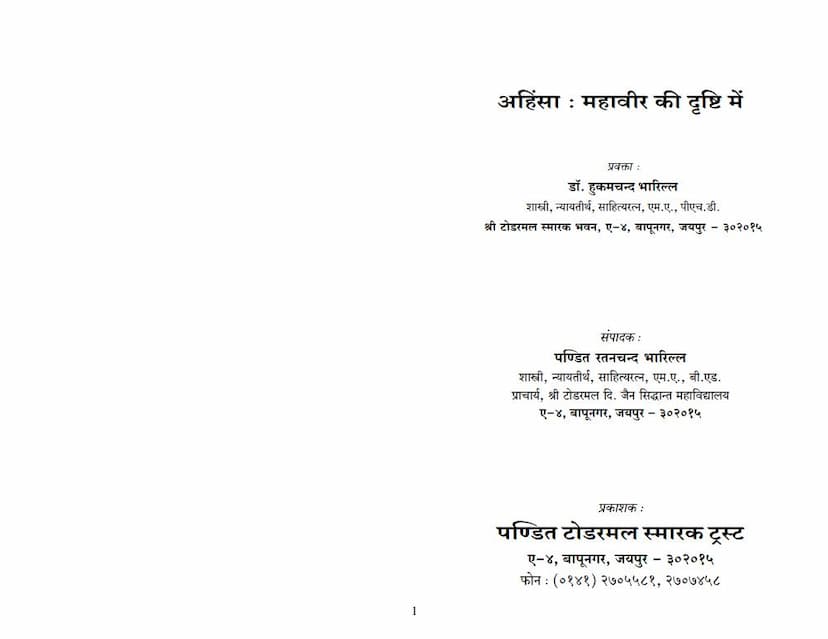Ahimsa Mahavira Ki Drushti Me
Added to library: September 1, 2025

Summary
Here is a comprehensive summary in English of the Jain text "Ahimsa: Mahavir Ki Drishti Mein" by Dr. Hukumchand Bharilla:
Title: Ahimsa: Mahavir Ki Drishti Mein (Ahimsa in the Vision of Mahavir) Author: Dr. Hukumchand Bharilla Publisher: Todarmal Granthamala Jaipur
This book, a compilation of lectures by Dr. Hukumchand Bharilla, explores the profound and often misunderstood concept of Ahimsa (non-violence) as taught by Lord Mahavir. The work emphasizes that Mahavir's teachings on Ahimsa are not only relevant but critically important in today's world, which is characterized by unprecedented levels of violence.
Key Themes and Arguments:
-
The Enduring Relevance of Mahavir's Teachings: The book begins by establishing the continued relevance of Lord Mahavir's message, even 2500 years after his passing. The author argues that while external circumstances have changed drastically (from bullock carts to rockets), the core principles of Ahimsa remain essential for human well-being and peace. He counters the notion that Mahavir's teachings are "out of date" by asserting that true modernity lies in one's thoughts and principles, not just outward appearance or technological advancement.
-
The Modernity of Mahavir's Ahimsa: Dr. Bharilla powerfully illustrates how contemporary violence, in its scale and destructiveness (nuclear weapons, global conflicts), makes Mahavir's doctrine of Ahimsa more crucial than ever. He points out that the destructive power of modern warfare, capable of annihilating entire populations, underscores the urgent need for the principles of non-violence to prevent global annihilation. He contrasts the limited casualties of ancient wars with the potentially billions of deaths in a modern conflict, highlighting the dire consequences of unchecked violence.
-
The Deeper Meaning of Ahimsa: Beyond Physical Violence: A central argument of the book is that Lord Mahavir's concept of Ahimsa goes far beyond the mere absence of physical harm (dravya-himsa). The author explains that for Mahavir, the true essence of Ahimsa lies in the absence of internal states of violence, such as attachment (rag), aversion (dwesh), anger, pride, deceit, and greed (moha). These internal states, termed bhava-himsa (violence of emotions/intentions), are the root cause of all outward violence.
-
Rag (Attachment) as the Root of Violence: The book delves deeply into the concept of "rag" (attachment or affection) as the primary driver of violence. The author explains that what the world often considers as love or affection (rag) is, from Mahavir's perspective, a form of violence. This is because attachment to possessions, people, or even ideals can lead to conflict, possessiveness, and ultimately, harm when these attachments are threatened or challenged.
- Examples are given of how attachment to wealth ("jar"), women ("joru"), and land ("jameen") fuels wars throughout history.
- Even seemingly positive attachments, like devotion to religion ("dharm-anurag"), can, if pursued without equanimity and understanding, lead to sectarian violence and bloodshed, as evidenced by historical conflicts.
-
The Three Types of Violence and Their Roots: The text explains that violence manifests through the mind (man), speech (vachan), and body (kaya). While physical violence (kaya-himsa) is often regulated by law, verbal abuse (vachan-himsa) and mental violence (man-himsa) are more pervasive and insidious. Mahavir's focus on eliminating violence at the source – the mind or soul (atma) – is highlighted. He aimed to prevent the arising of violent intentions, thereby stopping them from manifesting through speech and action.
-
The Importance of Understanding and Inner Purity: The author emphasizes that genuine Ahimsa requires deep introspection and the purification of one's inner states. Simply refraining from physical harm without addressing the underlying mental and emotional causes is insufficient. He uses the analogy of a doctor treating the root cause of an illness rather than just the symptoms.
-
Societal Indifference to Violence: The book laments the growing desensitization in modern society towards violence and suffering. People often witness and even discuss tragic events with detachment, highlighting a decline in empathy and compassion. This societal indifference makes Mahavir's call for inner purification even more vital.
-
The True Nature of Ahimsa as Equanimity: Ultimately, the book presents Mahavir's Ahimsa as the state of equanimity, free from attachment and aversion. It's about cultivating a balanced and detached perspective towards all beings and situations. This state of "vitaraagta" (freedom from passions) is the highest form of non-violence and the path to true happiness and peace.
Conclusion:
"Ahimsa: Mahavir Ki Drishti Mein" is a compelling defense of Jainism's core principle of Ahimsa, arguing that its true meaning lies in the mastery of internal passions rather than just the avoidance of external harm. Dr. Bharilla urges readers to understand and embrace this profound philosophy to navigate the complexities and challenges of the modern world, leading to individual and collective peace and well-being. The book serves as a call to action for personal transformation, emphasizing that the journey towards a non-violent world begins within each individual.